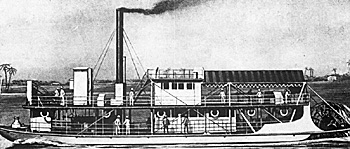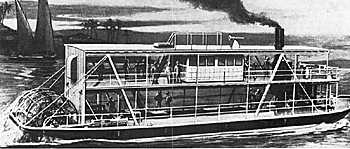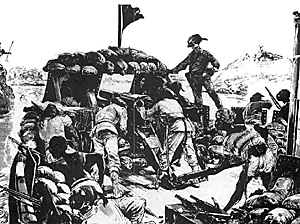Portions of this article originally appeared in SAVAGE AND SOLDIER Magazine, Vol. X No. 1, Jan-Mar 1978.
Gunboats played important roles in several Victorian-era military campaigns, most notably the British campaigns in the Sudan. Who can forget the scene from Khartoum when Col. Stewart left Khartoum on the converted paddle steamer in a vain attempt to reach freedom? With artillery pieces and machine guns blazing the boat tried to fight its way through the Mahdi's lines.
 MELIK class gunboat with all armor plating fitted. Note hinged armored shutters on front of pilot house. - Navy and Army Illustrated.
MELIK class gunboat with all armor plating fitted. Note hinged armored shutters on front of pilot house. - Navy and Army Illustrated.
You may also remember the excellent gunboat models which appeared in Alexander Korda's The Four Feathers. The scenes of the friendlies towing the Sultan over the cataracts were very realistic.
This article does not intend to be a history of gunboats in Victorian warfare (though I've included a brief overview of the gunboats which participated in the Omdurman campaign), rather, it will present ideas about building gunboats and using them in conjunction with your miniature wargames of the era.
Kitchener's Flotilla
Kitchener's flotilla for the final advance on Omdurman contained ten armed gunboats. Six of the boats were new craft, less than two years old. The other four were veterans of the 1884-5 campaign. Four other steamers accompanied the flotilla to serve, primarily, as towing vessels and were armed only with machine guns. Despite some reconaissance duties and the participation of six boats in the battle of Omdurman, the majority of work performed by the gunboats involved the transportation of troops and supplies. The hoped for battle with the Khalifa's gunboats never materialized.
The newest of the Sirclar's gunboats were the three twin-screw vessels of the Melik class - Melik, Sheikh and Sultan. These large gunboats were built in sections in England and assembled on the Nile. Previous gunboat classes had always been paddlewheelers to best take advantage of their shallow draft even at low water levels on the river. The Melik's, though screw-propeIled, drew even less water than the sternwheelers thanks to the novel method of mounting their screws - in tunnels within the hull proper.
Armament was impressive - two 12pdr QF guns, four Maxim guns and a four-inch howitzer. The boats were wellcovered with armor plate - being virtually immune to all forms of small arms fire.
The Zafir class (Zafir, Nassr and Fatteh) were large stern- wheelers designed for the Dongola campaign, though only the Zafir was completed on time. One 12pdr QF and two 6pdr QF guns were supplemented with three Maxim guns as armanent on theZafir's. The 12pdr was not very useful, though, as it was mounted on the forward portion of the main deck and was, therefore, usually too low to fire over the relatively high banks of the Nile.
The Tamai class gunboats Tamai, Metemmeh, Abu Klea and Hafir (ex-El Teb) were veterans of the 1884-5 Gordon Relief Expedition. They were small sternwheelers barely 90 feet long. Despite their size they were very handy in restricted waterways and their armament of one 9pdr Krupp gun and two Nordenfeldts was more than adequate.
The machine gun only armed boats were tha Dal, Kaibar, Akasha and Tahra. The first three were about the size of the Tamai class while the Tahra was an even smaller ex-Mahdist gunboat originally built by General Gordon. It has been sunk by the Egyptians at the Battle of Hafir and was subsequently raised and repaired. All of these steamers were used for towing barges and native boats, gyassas, loaded with troops and/or stores. The gunboats were also used for towing when needed (which was quite often), but these four small vessels were specifically assigned to the transport duties.
 Gunboat of the TAMAI Class. - Richard Anderson Collection.
Gunboat of the TAMAI Class. - Richard Anderson Collection.
Typical crews for the gunboats consisted of an English officer in command, two European engineers, one or two sergeants of the Royal Marine Artillery, and the fighting and working crews. Egyptian garrison artillerymen manned the guns. There were 23 to 27 gunners on the Zafir and Melik classes and eleven on the Tamai class gunboats. The deck crews were composed of Arabs from around Aswan and included a Chief Reis, Second Reis and eight crew on the large boats, five on the smaller. The firemen and trimmers were mostly blacks and numbered between five and eight, depending on the size of the gunboat.
RULES IDEAS FOR GUNBOATS
What's that you say? You don't have any rules for gunboats? Well, here are some suggestions and ideas for some gunboat rules. Important areas to consider are rifle fire, artillery fire, and boarding actions and their effects on the boat and its occupants. Other things that must be covered include armament, morale, speed and maneuverability.
Depending on the actual gunboat, rifle fire could have very little or a whole lot of effect on the boat and its occupants. Armored gunboats would provide virtual immunity from rifle fire to their crew and passengers. A normal gunboat(average run-of-the-mill type) would offer protection somewhat akin to a house. Some gunboats, however, were very lightly-built skeleton crafts with virtuaIly no cover for the people on board. Steam escaping from a bullet-riddled boiler usually proved fatal for anybody within 20 or 30 feet.
The greatest dangers presented by artillery shell fire on gunboats would be boiler explosions or fires. A boiler explosion would usually kill a lot of people, destroy most of the upper works and probably start a fire (all-in-all a rather nasty bunch of things to have happen to your gunboat all at once). Fires started by shells could usually be put out, assuming that the crew dropped everything they were doing and joined the bucket brigade. Other key areas for artillery damage would be the pilothouse, gun mounts, paddlewheels (if any), rudder and steering controls, ammunition storage and the engine. River gunboats, especially the small ones described here, could be very seriously damaged (or even sunk!) by a few well-placed artillery rounds.
 Yarrow-designed paddle gunboat for the Gordon Relief Expedition. A lightly-built craft offering little protection and mounting only garder guns. -Author's Collection
Yarrow-designed paddle gunboat for the Gordon Relief Expedition. A lightly-built craft offering little protection and mounting only garder guns. -Author's Collection
Boarding actions, whether from another gunboat, native craft or the shore, pose another problem to the use of gunboats in battles. Generally speaking, if an attempt to board the gunboat is made, everybody on board drops what they are doing and joins into the melee. I suggest that two rounds of fighting be played. On the first round, the attacker is trying to gain a foothold on the boat. if he succeeds, a second round of melee is fought for control of the boat.
Morale of the gunboat is yet another area needing consideration. In most cases the boat's morale would be good. A fire, a sinking condition or the death of the Captain would be situations where the crew's morale may have to be checked. If the boat is on fire or sinking, a bad morale test would probably result in the crew abandoning the gunboat. Loss of morale due to the death of the Captain would probably result in the gunboat withdrawing from the action.
 Hastily converted Egyptian gunboat mounting an artillery piece in the bow. Note sandbag and boiler plate armor. - Author's Collection
Hastily converted Egyptian gunboat mounting an artillery piece in the bow. Note sandbag and boiler plate armor. - Author's Collection
Maneuverability of the gunboat would be scaled to the movement of your troops on the battlefield. I suggest approximately oneinch per knot of actual speed. If the gunboat is operating on a river, the course and strength of the current must be established before the game. When operating upstream, the strength of the current should be subtracted from the gunboat's speed. When running with the current, it should be added to the boat's speed. Gunboats, by the nature of their designed purpose, were surprisingly maneuverable. I suggest using a turning circle about 4-6" in diameter, marked off in one-inch increments around the edge. Starting, stopping and reversing direction must also be considered when establishing maneuverability.
The use of gunboats in Colonial wargames can add both excitement and variety to the contest. A well-developed set of rules and a realistic looking boat will give a break to the usual sort of hum- drum Colonial battles. Good luck and good gaming!
Back to Table of Contents -- Courier Vol. V #6
To Courier List of Issues
To MagWeb Master Magazine List
© Copyright 1984 by The Courier Publishing Company.
This article appears in MagWeb (Magazine Web) on the Internet World Wide Web.
Other military history articles and gaming articles are available at http://www.magweb.com